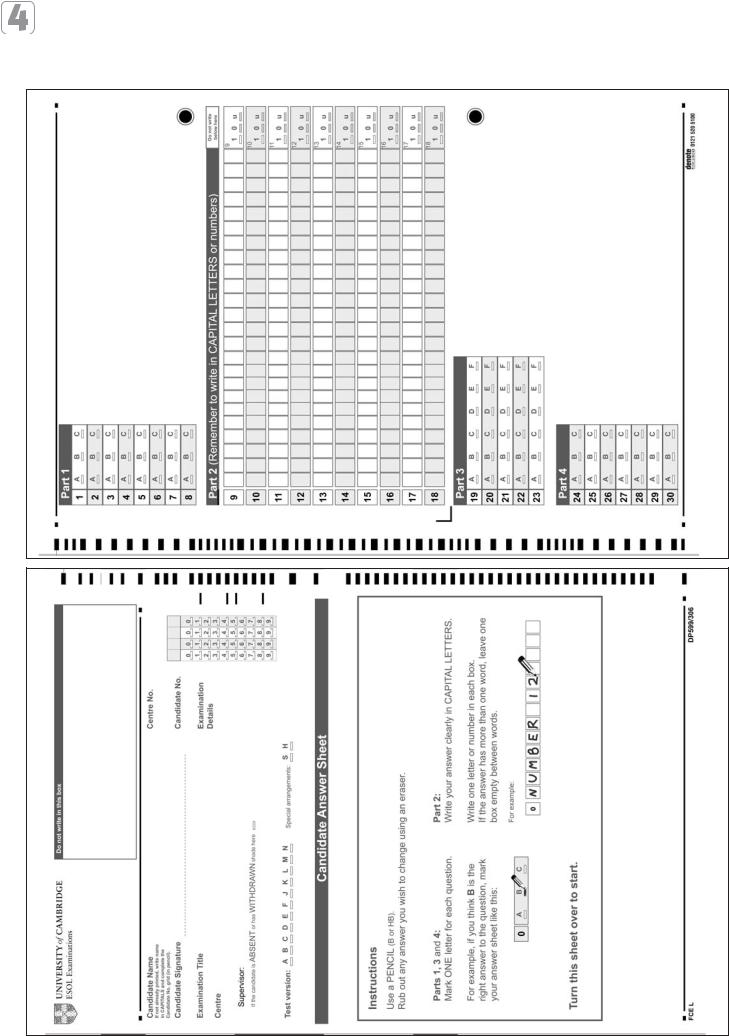
fce_handbook
.pdf
least we’d all know where we stood. I could have got there in the car by now, if they’d said.
PAUSE 2 SECONDS
— *** —
REPEAT EXTRACT 3
PAUSE 2 SECONDS
Four.
You hear a woman on the radio giving advice to listeners.
What is she giving advice about?
Athrowing things away
Bbuying new clothes
Ccollecting things
PAUSE 2 SECONDS
— *** —
We often keep stuff because we cannot face the task of sorting it all out. We still believe that one day it will all come in useful. Your home and your office reflect your personality. Getting rid of things makes us feel lighter, mentally and physically. Clothes are often a problem: our wardrobes are full but we still say, ‘I’ve nothing to wear’ when we really mean ‘Nothing looks good on me.’ A simple rule: if you haven’t worn it in the past year, then call it a day!
PAUSE 2 SECONDS
— *** —
REPEAT EXTRACT 4
PAUSE 2 SECONDS
Five.
You hear a man and a woman talking about going to the gym.
What does the man say about going to the gym?
AIt is too expensive for him.
BIt takes too much of his time.
CIt is too physically demanding.
PAUSE 2 SECONDS
— *** —
Woman: So, that didn’t last long, did it? Two weeks going to
the gym, and you’re already talking of giving it up ...
Man: Look, if you’re saying I’m not up to it, you’re wrong. I realise it’s very effective in working every muscle, and when I get started, it’s just like other sports. I don’t even mind feeling exhausted at the end. But, listen, you sort out your kit at home, lug it to the gym, queue to pay your entrance fee, then change and queue for the machines ...
when you could have been for a run straight from your home and then been free to get on with your life.
Woman: Well, I think you’re wrong, and you should make the effort to carry on.
PAUSE 2 SECONDS
— *** —
REPEAT EXTRACT 5
PAUSE 2 SECONDS
Six.
You overhear a man talking on the phone about his work.
What does he think about his new job?
AIt is better than he expected.
BIt is going to be difficult.
CIt is similar to his last job.
PAUSE 2 SECONDS
— *** —
Well, made it to the end of the first week in one piece … yeah, not bad, I mean the work I’m doing isn’t any different really but you have to get used to a new set of people, don’t you? They’re all pretty nice I think – with the possible exception of my boss – she seems a bit terrifying but maybe that’s just first impressions, we’ll see. And I can see I’ll probably be doing quite a lot of extra hours … Oh yes, good overtime rates, but that’s normal in my line of work … No, I don’t think so … [fade]
PAUSE 2 SECONDS
— *** —
REPEAT EXTRACT 6
PAUSE 2 SECONDS
Seven.
You hear a young musician talking on the radio.
How does he feel about his career?
Adisappointed not to have won a competition
Bunconcerned about his lack of qualifications
Csorry not to have kept a promise
PAUSE 2 SECONDS
— *** —
I used to bang metal dustbin lids with spoons and chopsticks in time to the radio. My mum worked nights and we lived in a flat, you can imagine the arguments, but I got my drums in the end. The year I finished school, I reached the finals of a competition called ‘Young Musician of the Year’ and found a job as a drummer with a touring dance show. I promised Mum that I’d go to college to study when the work ran out, but that was five years ago! Now, I can’t see the point. I’m doing what I’ve always wanted to do and I’m making a go of it.
PAUSE 2 SECONDS
— *** —
REPEAT EXTRACT 7
PAUSE 2 SECONDS
Eight.
You overhear a woman telling a colleague about an outdoor activity course.
f c e h a n d b o o k f o r t e a c h e r s | pa pe r 4 : l iste n i n g | sa m p l e ta pe sc r i p t – te st 2 |
69 |
|
|

What is the woman’s opinion of the course?
AIt was frightening.
BIt was difficult.
CIt was useful.
PAUSE 2 SECONDS
— *** —
Man: What did you think of that outdoor activity course the company sent you on last week?
Woman: Funnily enough, I enjoyed it. Mountain climbing’s really fun!
Man: I’d hate it. I’m too scared of heights. Far too dangerous.
Woman: Some people did find it too much. It was tough, I’ll admit. But what a challenge! I felt great when I’d done it. The fear disappears when you’re concentrating on the climbing. Mind you, I don’t really see how it helps us become better employees. The company must think it’s worth it though, because they’ve spent a lot on these courses over the years.
PAUSE 2 SECONDS
— *** —
REPEAT EXTRACT 8
PAUSE 2 SECONDS
That’s the end of Part 1.
Now turn to Part 2.
PAUSE 5 SECONDS
You’ll hear a radio report about a trip to an animal fair in India. For questions 9–18, complete the sentences.
You now have 45 seconds to look at Part 2.
PAUSE 45 SECONDS
— *** —
I had always wanted to visit one of the famous animal fairs that are held throughout India. So I was delighted when I was asked to go to India and report on one for this programme. The fair I was going to look at was at a place called Sonepur, which is in the north-east of India. To get there I had to take two planes and then take a short taxi ride. As my taxi approached the place where the fair was being held, it was obvious something special was going on. The passengers in the other three-wheeler taxis were all dressed in their very best clothes, some made of silver and gold cloth, the women with their arms covered in glass bracelets.
As I got nearer to the fairground I spotted my first elephant – only it was not walking to the fair, but was being transported in the truck up ahead. Sonepur is famed for its fair, held once a year. It usually begins in the third week in November and for nearly a month the elephants are displayed and traded, prices agreed upon and periodic maintenance carried out by experienced elephant keepers – there are even specialists on hand to look at the elephants’ teeth.
And it is the elephants you see first, once you have made it through the crowds of people and taxis. They stand motionless or swaying from foot to foot, their foreheads and ears and trunks covered in floral or geometric tattoos. Their privileged position – closest to the river – is part of an ancient tradition. The origins of this fair go back many years, and while the number of elephants has fallen from several hundred to around 70, they still make an impressive assembly.
At the back of the elephant area is the enormous tent of a travelling theatre, surrounded by side-shows and fairground stalls. Behind these are rows of shops selling tea and soft drinks.
As for food, there was no end of choice. I could see mounds of brightly coloured fruit and fresh baked bread. It was nearly lunchtime and all this food made me feel hungry. I looked up and down the rows until I found a man expertly cooking rice, which tasted as good as it looked.
I was beginning to appreciate the size of this fair. It was as if a city had grown out of the soil. Different alleyways sold everything that a farmer who had sold his crop could wish to spend his money on, from costly leather goods to cheap embroidered cloth.
I climbed a small hill to regain my sense of direction and was amazed to see that behind the fairground was an open plain, full, as far as the eye could see, of cows. There were thousands of them and there was some serious business going on in the viewing areas.
From there, I moved on to the Horse Fair in another clearly defined area. The dealers sat patiently waiting for customers. Families would come, each looking for a white horse for their son to ride at his wedding, which is a custom of this country. These horses were wearing saddles and bridles richly decorated with silver and gold and were kept safe in the dealers’ tents. Outside, some of the younger horse-dealers were watering their horses while others showed off their riding skills, leaning far back in the saddle or standing up as they moved from a trot to a gallop.
By now the sun had lost its earlier intensity and smoke had begun to rise from the campfires. I decided it was time to leave, so I wandered back to the elephant area where I knew I could find a taxi to take me back to my hotel. For me, it had been a wonderful experience.
PAUSE 10 SECONDS
Now you’ll hear Part 2 again.
— *** —
REPEAT PART 2
PAUSE 5 SECONDS
That’s the end of Part 2.
70 |
f c e h a n d b o o k f o r t e a c h e r s | pa pe r 4 : l iste n i n g | sa m p l e ta pe sc r i p t – te st 2 |
|
|

Now turn to Part 3.
PAUSE 5 SECONDS
You’ll hear five different people talking about hairstyles. For questions 19–23, choose from the list (A–F) what each speaker says. Use the letters only once. There is one extra letter which you do not need to use.
You now have 30 seconds to look at Part 3.
PAUSE 30 SECONDS
— *** —
Speaker 1
PAUSE 2 SECONDS
There are some fixed ideas about which hairstyles are ‘professional’. Most people seem to think that short styles are more businesslike. There was an example recently of a woman who announced the weather report on television. When she started she had lovely, flowing red hair but after the first few broadcasts her boss told her to tie it back. So now she has it pulled right off her face. The idea is, I suppose, that she would make the weather report seem unimportant if she had her long hair loose. It all seems very strange to me.
PAUSE 3 SECONDS
Speaker 2
PAUSE 2 SECONDS
Personally I think the new short hairstyles, far from being dull, are actually much more flattering. So many women hold on to their old look and it’s a shame. Sometimes they’re just too used to seeing themselves in a certain way or they think it fits their professional image. They should really move on and try a modern shorter cut that would take years off them, give them a fresher look. There are a few exceptions of course – people who look good with long hair like some actresses, who in any case can afford top stylists, but I think most more mature women would benefit enormously from rethinking their look.
PAUSE 3 SECONDS
Speaker 3
PAUSE 2 SECONDS
I think it’s great that you can have your hair any way you want these days. When I look at photos of my mother, for example, she had the same long hair for about forty years! Nowadays, you see people with their heads shaved – men and women – or their hair is green or purple or whatever colour they fancy. And it’s not just the young who are experimenting. I’ve seen people my age who are not afraid to try something new. At one time, your job affected how daring you were, but in this day and age, if you’ve got enough confidence, you can do as you please.
PAUSE 3 SECONDS
Speaker 4
PAUSE 2 SECONDS
I think the whole haircutting profession is actually a plot. The thing about long hair is you have to get it cut so rarely and obviously that’s not at all profitable for the trade. I’ve had my hair short before because I was persuaded to try it, but it was a disaster. It only looked good immediately after I’d had it styled, and in my job I need to look attractive and well presented. So that meant of course that I had to have it done more and more often which was a real strain on my time and on my purse!
PAUSE 3 SECONDS
Speaker 5
PAUSE 2 SECONDS
I think certain hairstyles are symbolic, don’t you? Centuries ago, the fashion was for girls to have hair right down their backs until they grew up and married. I wonder sometimes if some women are reluctant to cut their hair because maybe they see it as a final admission to the world that they’ve become middle-aged. Look at some of our singers and actors in their forties still with long hair – when really I think they should be changing to a more mature and fashionable style. But there again, the world would be a dull place if we all looked the same, wouldn’t it?
PAUSE 10 SECONDS
Now you’ll hear Part 3 again.
— *** —
REPEAT PART 3
PAUSE 5 SECONDS
That is the end of Part 3.
Now turn to Part 4.
PAUSE 5 SECONDS
You’ll hear a radio interview with a film actor called Will Dennis. For questions 24–30, choose the best answer (A, B or C).
You now have 1 minute to look at Part 4.
PAUSE 1 MINUTE
— *** —
Int: In the studio today we have the actor Will Dennis, whose new film, Starman, is just about to be released. Welcome, Will. When did you decide you wanted to become an actor?
Will: You know, I never said, ‘I want to be an actor’, and I didn’t really train formally. I just went to drama school briefly for about a year but it wasn’t up to much,
f c e h a n d b o o k f o r t e a c h e r s | pa pe r 4 : l iste n i n g | sa m p l e ta pe sc r i p t – te st 2 |
71 |
|
|

although there were some good people there who I really looked up to. I was just attracted to it, I guess I just found it appealing. I never had any particular role models or dreams of becoming a star or anything like that.
Int: Your first film role was going to be in a film called The Gate, wasn’t it? I know there were problems, can you tell me about them?
Will: Yeah – I had a very, very small part and I got fired from it. They had hired all these actors from New York and we had to stand around a lot because the film was about five days behind schedule as they were inventing new material all the time. It got really boring and during one bit someone told me a joke. It was during the filming and I laughed. So they let me go. They said it would cost a fortune to do that bit again and they didn’t want troublemakers on the set.
Int: So you left, just like that?
Will: Uh huh. All my friends were really shocked as they knew I wasn’t really a troublemaker. I guess I could have
– you know, got really angry – hired a lawyer and made a big deal of it. After all, it was my first Hollywood film and I might never get another one. But I decided to just accept the decision and go back to New York, where I felt I belonged.
Int: Things improved after that though, didn’t they, with a string of successful films to your credit. Is it true that you rarely watch your films?
Will: I watch them, but only once maybe. I don’t enjoy it because I find the process more fascinating than the final product. Also I can’t be objective about what I’ve done and that makes me depressed, even though it could help me see ways to improve my performance. But in the end, no matter how great a film is, it is just a couple of hours of what has been four months’ intense work, making new friendships and so on.
Int: It’s strange but you always seem to end up playing the bad guy.
Will: People do have that perception of me. Well, psychologists say you enjoy playing villains because you get to act on impulses you can’t act on in life. I think that’s what they say anyway. I wouldn’t agree with that myself. I just don’t feel the characters are that bad, they’re often just different, they’re often outsiders. I’m quite happy in those kinds of roles.
Int: Interesting. In your latest film, you did a lot of the stunts
– the action bits – yourself. Why did you do that?
Will: I liked the dangerous action stuff in this film when I read the script – it seemed like fun and a new challenge for me, more like a sport really. In the end the criterion for doing something or not doing it was: was it so dangerous that it was stupid for me to do it? But I felt I
was the best one to do it because otherwise you could tell it wasn’t me and the studio supported me in this.
Int: Was there any occasion when you refused?
Will: There was one time when I just said, ‘No’. It was a high fall, and even though I knew and trusted all the crew involved, it still scared me. I had to wear a mask to do the fall but I’d just done some fight sequences and my nose was really swollen. I thought that if I fell badly wearing the mask, then my nose would get broken. So that one I let someone else do.
Int: Well, I know I can’t wait to see the film. My thanks to Will … [fade]
PAUSE 10 SECONDS
Now you’ll hear Part 4 again.
— *** —
REPEAT PART 4
PAUSE 5 SECONDS
That is the end of Part 4.
There’ll now be a pause of 5 minutes for you to copy your answers onto the separate answer sheet. Be sure to follow the numbering of all the questions. I’ll remind you when there is 1 minute left, so that you’re sure to finish in time.
PAUSE 4 MINUTES
You have 1 more minute left.
PAUSE 1 MINUTE
That is the end of the test. Please stop now. Your supervisor will now collect all the question papers and answer sheets.
72 |
f c e h a n d b o o k f o r t e a c h e r s | pa pe r 4 : l iste n i n g | sa m p l e ta pe sc r i p t – te st 2 |
|
|

PAPER 4: LISTENING
Answer keys
Test 2
PART ONE |
PART TWO |
PART THREE |
PART FOUR |
|||||||
|
|
|
|
|
|
|
|
|
|
|
1 |
C |
9 |
glass |
19 |
F |
24 |
C |
|||
2 |
C |
10 |
(nearly) 1/one/a month |
20 |
D |
25 |
A |
|||
3 |
B |
11 |
teeth |
21 |
E |
26 |
B |
|||
4 |
A |
12 |
river |
22 |
B |
27 |
B |
|||
5 |
B |
13 |
tent |
23 |
A |
28 |
B |
|||
6 |
C |
14 |
rice |
|
|
29 |
C |
|||
7 |
B |
15 |
leather |
|
|
30 |
A |
|||
8 |
B |
16 |
cattle/cows |
|
|
|
|
|
||
|
|
17 |
wedding/marriage |
|
|
|
|
|
||
|
|
18 |
(their) (horse) riding (skill(s)/ |
|
|
|
|
|
||
|
|
|
|
ability/abilities) |
|
|
|
|
|
|
f c e h a n d b o o k f o r t e a c h e r s | pa pe r 4 : l iste n i n g | a ns we r k e ys f o r te st 2 |
73 |
|
|

PAPER 4: LISTENING
Candidate answer sheet
74 |
f c e h a n d b o o k f o r t e a c h e r s | pa pe r 4 : l iste n i n g | c a n d i date a ns we r sh e e t |
|
|

GENERAL DESCRIPTION
Paper format |
The Speaking test contains |
|
four parts. |
|
|
Timing |
14 minutes. |
|
|
No. of parts |
4. |
|
|
Interaction |
Two candidates and two |
pattern |
examiners. One examiner acts |
|
as both interlocutor and |
|
assessor and manages the |
|
interaction either by asking |
|
questions or providing cues for |
|
the candidates. The other acts |
|
as assessor and does not join in |
|
the conversation. |
|
|
Task types |
Short exchanges with the |
|
interlocutor and with the other |
|
candidate; a 1 minute |
|
‘long turn’; a collaborative task |
|
involving the two candidates; |
|
a discussion. |
|
|
Marks |
Candidates are assessed on |
|
their performance throughout. |
|
|
PAPER 5
STRUCTURE AND TASKS
PART 1
Task type |
A conversation between the interlocutor and each |
and format |
candidate (spoken questions). |
|
|
Focus |
General interactional and social language. |
|
|
Timing |
3 minutes. |
|
|
PART 2
Task type |
An individual ‘long turn’ for each candidate with a |
and format |
brief response from the second candidate. |
|
In turn, the candidates are given a pair of |
|
photographs to talk about. |
|
|
Focus |
Organising a larger unit of discourse; comparing, |
|
describing, expressing opinions. |
|
|
Timing |
A 1 minute ‘long turn’ for each candidate, plus 20- |
|
second response from the second candidate. |
|
|
PART 3
Task type |
A two-way conversation between the candidates. |
and format |
The candidates are given spoken instructions |
|
with written and visual stimuli, which are used in |
|
a decision-making task. |
|
|
Focus |
Sustaining an interaction; exchanging ideas, |
|
expressing and justifying opinions, agreeing |
|
and/or disagreeing, suggesting, speculating, |
|
evaluating, reaching a decision through |
|
negotiation, etc. |
|
|
Timing |
3 minutes. |
|
|
PART 4
Task type |
A discussion on topics related to the collaborative |
and format |
task (spoken questions). |
|
|
Focus |
Expressing and justifying opinions, agreeing |
|
and/or disagreeing. |
|
|
Timing |
4 minutes. |
|
|
f c e h a n d b o o k f o r t e a c h e r s | pa pe r 5 : s pe a k i n g |
75 |
|
|

The four parts of the
Speaking test
■ Format
The paired format for the FCE Speaking test (two examiners and two candidates) offers candidates the opportunity to demonstrate, in a controlled but friendly environment, their ability to use their spoken language skills effectively. The test takes 14 minutes. One examiner, the interlocutor, conducts the test and gives a global assessment of each candidate’s performance. The other, the assessor, does not take any part in the interaction but focuses solely on listening to, and making an assessment of, each candidate’s oral proficiency.
At the end of the Speaking test, candidates are thanked for attending. They are given no indication of the level of their achievement.
The standard format is two examiners and two candidates. In cases where there is an uneven number of candidates at a centre, the last Speaking test of the session will be taken by three candidates together instead of two. When three candidates are tested together, the test format, test material and procedure will remain unchanged, but the timing will be longer: 20 minutes instead of 14.
The Speaking test consists of four parts, each of which is assessed. Each part of the test focuses on a different type of interaction: between the interlocutor and each candidate, between the two candidates, and among all three. The patterns of discourse vary within each part of the test.
■ PART 1 – INTERVIEW
This part tests the candidates’ ability to use social and interactional language.
Sample tasks and assessment criteria: pages 79, 83 and 86–87.
Part 1 gives candidates the opportunity to show their ability to use general social and interactional language and to give basic personal information about themselves. The questions which are asked relate to the candidates’ own lives and focus on areas such as work, leisure time and future plans. Candidates are expected to respond to the interlocutor’s questions, and to listen to what their partner has to say.
The candidates are not actively invited to talk to each other in this part of the test, though they may if they wish. This short social exchange is a natural way to begin an interaction, and it gives candidates time to settle before dealing with the more specific tasks in Parts 2, 3 and 4.
■ PART 2 – LONG TURN
This part tests the candidates’ ability to produce an extended piece of discourse.
Sample tasks and assessment criteria: pages 80, 84 and 86–87.
In Part 2, candidates are given the opportunity to speak for 1 minute without interruption. Each candidate is asked to compare two colour photographs, and to make a further comment about them in response to a task that is read out by the interlocutor. A prompt is given to the candidates in the form of a direct question; this is written above the photographs. Candidates are expected to point out the similarities and differences between the photographs and then move on to deal with the question.
Candidates have the opportunity to show their ability to organise their thoughts and ideas, and express themselves coherently with appropriate language. The listening candidate is also asked to comment briefly (for about 20 seconds) after their partner’s long turn. They should not speak during their partner’s long turn.
■ PART 3 – COLLABORATIVE TASK
This part tests the candidates’ ability to engage in a discussion and to work towards a negotiated outcome of the task set.
Sample tasks and assessment criteria: pages 81, 85 and 86–87.
In Part 3, candidates are given oral instructions and provided with a visual stimulus (several photographs or pieces of artwork) to form the basis for a task which they carry out together. They are expected to discuss each visual, expressing and justifying opinions, evaluating and speculating, in order to work towards a negotiated decision towards the end of the task. The instructions make these two parts of the task clear: ‘First, talk to each other about …’. ‘Then decide …’. The decision should only be made after the candidates have explored each of the issues as illustrated by the pictures, and they are assessed on their ability to use the language of negotiation and collaboration while doing this. However, they are not penalised if they fail to reach a negotiated decision. Written prompts, in the form of questions, appear above the visuals on the candidates’ sheet to help them focus on the task.
There is no right or wrong answer to the task. The task gives candidates the opportunity to show their range of language and their ability to invite the opinions and ideas of their partner. Candidates are expected to share the interaction in this way and to initiate and respond appropriately.
76 |
f c e h a n d b o o k f o r t e a c h e r s | pa pe r 5 : s pe a k i n g |
|
|

■ PART 4 – DISCUSSION
This part tests the candidates’ ability to engage in a discussion based on the topic of the collaborative task in Part 3
Sample tasks and assessment criteria: pages 81, 85 and 86–87.
In Part 4, the interlocutor directs the interaction by asking questions which encourage the candidates to broaden and discuss further the topics introduced in Part 3. The questions differ from Part 1 in that they ask primarily for an evaluation rather than for information.
This part of the test gives candidates an opportunity to show that they are capable of discussing issues in more depth than in the earlier parts of the test.
Preparation
General
■Classroom activities which involve students working in pairs and small groups will give practice in skills such as initiating and responding, which are essential to success in the Speaking test.
■Make sure your students are familiar with the format of each part of the test. They should be aware of the different interaction patterns (who speaks to whom) and what stimulus will be provided by the interlocutor.
■Encourage your students to speak clearly so that they can be heard by both the interlocutor and assessor. They should be made aware that different varieties of English accents in the UK and elswhere in the world are acceptable.
■Train your students to paraphrase when they do not know, or cannot remember, a word.
■Train your students to listen carefully to the instructions, and to read the questions above the pictures, so that they know precisely what they have to talk about.
■To ensure all candidates are treated fairly, the interlocutor keeps to a scripted frame (as shown in the sample papers). However, you may remind your students that they can ask the examiner to repeat the instructions or a question.
■Encourage your students to initiate discussion and to respond to what other students have to say.
N.B. In some centres candidates from the same school are paired together. However, where candidates from a number of different schools are entered at the same centre, some candidates may find that they are paired with a candidate from another school. Students may check with the centre through which they are entering for the local procedure, if they wish.
By part
■PART 1
■In this part of the test, students will benefit from finding opportunities to practise talking about themselves. Interlocutors will ask candidates a range of questions about their everyday life, for example sports they enjoy, travel and holidays, work experience and so on. Encourage your students to respond promptly, with answers which are complete and spontaneous. Rehearsed speeches should be avoided as these might be inappropriate for the question asked.
■Encourage your students to look for opportunities to socialise with English speakers. In class, they could role-play social occasions in which they meet new people, e.g. parties, train journeys, starting a new job. This will give them the opportunity to practise a range of topics for this part of the test.
■Students could brainstorm possible questions from the categories above. The different groups could then answer each other’s questions.
■PART 2
■Teach your students to listen carefully to the instructions and to carry them out. Remind them that they should listen carefully to the instructions which follow the words ‘and say’
and read the question above the photographs. If they do not do this they may miss the focus of the task and not produce a wide enough range of language, or they may find it difficult to speak for the full minute.
■Students should be confident that they know what they have to say before they start their long turn. Remind your students that they will not lose marks if they ask the examiner to repeat the instructions.
■Students sometimes find that a minute is quite a long time to talk. Give your students practice at talking for a minute about a given topic. Topics and visuals in FCE coursebooks will be appropriate for this practice. Give them plenty of practice in organising an extended turn and in linking their ideas together. Time this practice so that your students get a feel for how long a minute is. Without this, they may finish the task too quickly and as a result fail to give the examiners an adequate sample of language.
■Give your students practice by cutting thematically linked pairs of photographs from magazines and giving these an additional focus as in the test. For example, you might choose photographs of two different types of holiday and ask your students to compare the photographs and say what people would enjoy about a holiday in each of the different places.
■Encourage your students to bring their own photographs to class and to speak about them.
■Candidates are not expected to give detailed descriptions of each picture. Rather, they are asked to compare the pictures and to give their reaction to them. Get your students to work
f c e h a n d b o o k f o r t e a c h e r s | pa pe r 5 : s pe a k i n g |
77 |
|
|

in pairs or small groups and to share their ideas about what they might say, before they attempt a task.
■Students often find it useful to observe a good model answer given by a more advanced learner of English or by the teacher.
■Encourage your students to focus on useful language for this part of the test. In particular, ways of expressing similarity and difference may help, e.g. ‘one similarity is that ...’; ‘In this picture there’s … whereas in the other there’s …’. Remind your students that using comparatives and linking words will produce a more extended and coherent sample of speech than simply stringing together a series of simple statements. This will help them to gain marks under the Discourse Management assessment criterion.
■Play games such as Just a Minute where candidates have to speak for 1 minute without repeating themselves.
■PART 3
■In this part of the test, the interlocutor’s instructions will be: ‘First talk about … .’ ‘Then decide …’. The ‘First talk about …’
instruction forms the bulk of the task. Encourage your students to discuss the content of the visual prompts as fully as possible before moving on to negotiate a decision. Tell them that they will not lose marks if they fail to reach a decision, provided that they have discussed the visual prompts fully.
■It is very important for candidates to interact with each other when they carry out the Part 3 task. All classroom discussion in pairs and small groups, therefore, provides excellent preparation.
■Remind your students to make positive contributions to move the discussion forward. They should be encouraged to respond to each other’s contributions by agreeing, disagreeing and questioning each other, rather than just giving information about the task.
■In classroom activities, one student in each group could be made responsible for ensuring that every member of the group gets an equal opportunity to speak, so that the students become alerted to the importance of turn-taking.
■It may be useful to focus on accurate production of functional language likely to be useful in this type of discussion. This may include ways of managing the discussion, e.g. ‘Shall we start with this one?’; ‘What do you think?’; ‘Shall we move on to ... ?’. Ways of expressing and justifying opinions, and agreeing and disagreeing (politely) are also likely to be useful.
■PART 4
■Encourage your students to give full answers to the questions asked. They can do this by keeping useful question words in their heads, e.g. ‘Why?’, ‘How?’, ‘When?’, ‘Where?’. If, when answering a question, they move on to responding to related question words, they will give full contributions. For example, in response to a question following Part 3 on the
subject of ‘Holidays’ students could be asked ‘Would you like to go on a holiday like this?’. Students could answer ‘yes’, giving the reasons why they would like a particular holiday, when they would like to go, where they would go, and so on. The question ‘Why?’ is useful for nearly all Part 4 questions and the interlocutor will often ask this question if students fail to give more than a minimal response.
■Let your students practise asking each other for their opinions on everyday situations and current events, and encourage them to give full answers to the questions asked in the way suggested above.
■Candidates may be asked individual questions, but they may also choose to involve their partner in the discussion. Therefore, as with Part 3, classroom discussions in pairs and small groups provide excellent preparation.
■In order to raise awareness of the types of questions asked and of effective ways of answering them, it may be helpful to give pairs of students different topics and to ask each pair to think of six discussion questions for their topic. These sets of questions could then be exchanged by the different pairs and discussed.
■Remind your students that there are no right answers to the questions and candidates will not be judged on their opinions, only on the language they use to express their opinions. It is quite acceptable for candidates to admit to not knowing much about a particular question, but they should be taught to expand on their views wherever possible and should be discouraged from making responses such as ‘I don’t know’, ‘I’m not sure’ or ‘I haven’t thought about that’.
78 |
f c e h a n d b o o k f o r t e a c h e r s | pa pe r 5 : s pe a k i n g |
|
|
